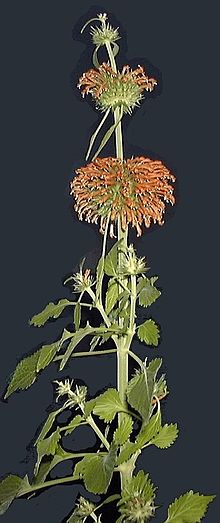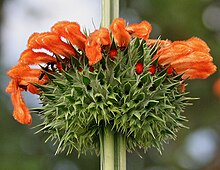Lion ears
| Lion ears | ||||||||||||
|---|---|---|---|---|---|---|---|---|---|---|---|---|

Small-leaved lion's ear ( Leonotis nepetifolia ) |
||||||||||||
| Systematics | ||||||||||||
|
||||||||||||
| Scientific name | ||||||||||||
| Leonotis | ||||||||||||
| ( Pers. ) R.Br. |
Lion's ear ( Leonotis ), also known as the lion's tail, is a genus of plants in the mint family (Lamiaceae).
description


Appearance and leaves
Leonotis species grow as annual to evergreen, perennial herbaceous plants or subshrubs that usually reach heights of 0.6 to 2, rarely up to 5 meters. They contain essential oils and therefore smell aromatic. Most parts of the plant are hairy. Young stems are usually square.
The opposite leaves are divided into petiole and leaf blade. The simple leaf blades are flat and ovate to lanceolate. The leaf margin can be whole, notched or serrated. Stipules are missing.
Inflorescences, flowers and fruits
The entire inflorescence is composed of several (three to eleven) axillary, dense, multi-flowered, almost spherical pseudo whorls arranged at a distance from each other on the stem . The bracts are foliage-like and the bracts are elongated, often with a thorny tip. There are flower stalks.
The showy, hermaphrodite flowers are zygomorphic and five-fold with a double flower envelope . The five sepals are fused together and the calyx tube ends in eight to ten calyx teeth, often with a thorny tip. The five bright orange to white petals have grown together to form a curved corolla tube that ends with two lips. The upper lip is densely hairy. The lower lip is three-lobed. There is a circle with four fertile stamens ; the lower pair is significantly longer. Two carpels have grown together to form an upper ovary, which is often divided into four chambers by a "false septum". The stylus ends in a small, bilobed scar.
The Klaus fruits disintegrate in rarely only two, mostly four Klausen.
Systematics and distribution
It was first published in 1807 as the subgenus Phlomis subg. Leonotis Pers. by Christian Hendrik Persoon in Synopsis Plantarum , 2, 1, page 127. Leonotis received the rank of a genus in 1810 by Robert Brown in Prodromus Florae Novae Hollandiae , page 504. The botanical genus name Leonotis is derived from the Greek words leon , leontos for lion and otos for ear and refers to the shape of the corolla. Synonyms for Leonotis (Pers.) R.Br. are: Leonurus Mill. nom. illeg., Hemisodon Raf.
Leonotis is not monophyletic to the extent that it was in 2003 ; its species could then be merged into a species-rich genus Leucas R.Br. be asked.
All Leonotis species are native to tropical to southern Africa . An exception is the species Leonotis nepetifolia , which can also be found in South India and the New World; in Australia this species is considered an invasive plant .
There are around nine (30 to 40) species of Leonotis :
- Leonotis decadonta Gürke : The three varieties are from Rwanda to southern tropical Africa.
- Leonotis goetzei Gürke : It only occurs in southwestern Tanzania .
- Leonotis grandis Iwarsson & YBHarv. : It was first described in 2003 and occurs from southern Tanzania via Malawi to northeastern Zambia .
- African lion's ear , large-leaved lion's ear ( Leonotis leonurus (L.) R.Br. ): It occurs in southern Africa .
- Leonotis myricifolia Iwarsson & YBHarv. : It was first described in 2003 and occurs from southwestern Tanzania via Malawi to eastern Zambia.
- Leonotis myrothamnifolia Iwarsson & YBHarv. : It was first described in 2003 and occurs only in Malawi and Zambia (only on the Mafinga Hills).
- Small-leaved lion's ear ( Leonotis nepetifolia (L.) R.Br. ): The two varieties are common in Africa and the Indian subcontinent . The nominate form is a neophyte in many areas of the world . Their chromosome number is 2n = 24 or 26.
- Leonotis ocymifolia (Burm. F.) Iwarsson (Syn .: Leonotis leonitis (L.) R.Br. , Leonotis ovata Spreng. , Leonotis parvifolia Benth. , Leonotis capensis Raf. , Leonotis dubia E. Me. Ex Benth. , Leonotis mollis Benth. , Leonotis hirtiflora Benth. , Leonotis leonitis var. hirtiflora (Benth.) Skan ): The three varieties arewidespreadfrom Eritrea to southern Africa.
- Leonotis pole-evansii Hutch. : It occurs only in northern and central Zambia.
use
Some species and their varieties are used as ornamental plants .
swell
- TR Lally: Leonotis In: FloraBase - The Western Australian Flora - online , 2008.
Individual evidence
- ^ Leonotis at Tropicos.org. Missouri Botanical Garden, St. Louis, accessed January 5, 2018.
- ↑ a b c d e f g h i j k Rafaël Govaerts (Ed.): Leonotis. In: World Checklist of Selected Plant Families (WCSP) - The Board of Trustees of the Royal Botanic Gardens, Kew . Retrieved January 5, 2018.
- ^ Leonotis in the Germplasm Resources Information Network (GRIN), USDA , ARS , National Genetic Resources Program. National Germplasm Resources Laboratory, Beltsville, Maryland. Retrieved December 18, 2014.
- ↑ Leonotis nepetifolia at Tropicos.org. In: IPCN Chromosome Reports . Missouri Botanical Garden, St. Louis
literature
- M. Iwarsson, Y. Harvey: Monograph of the genus Leonotis (Pers.) R.Br. (Lamiaceae). In: Kew Bulletin , Volume 58, 2003, pp. 597-645.
Web links
- Entry in the Flora of Zimbabwe .
- Leonotis leonurus. In: Erowid . (English)

